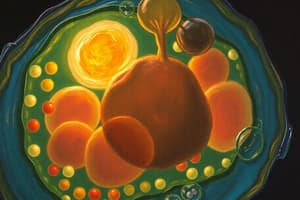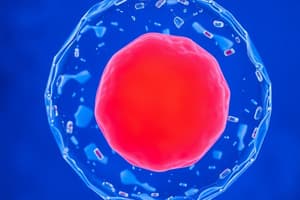Podcast
Questions and Answers
What is the analogy for the Plasma Membrane?
What is the analogy for the Plasma Membrane?
- Hospital waiting room (correct)
- Hospital room
- Medicine room
- Doctor's office
The Nucleus is analogous to which part of a hospital?
The Nucleus is analogous to which part of a hospital?
- Patients
- Doctor's office
- Hospital rooms (correct)
- Hospital design
How is the Cytoskeleton compared to a hospital?
How is the Cytoskeleton compared to a hospital?
- Hospital waiting room
- Medicine room
- Patients
- Stretcher (correct)
What does the Mitochondrion represent in the hospital analogy?
What does the Mitochondrion represent in the hospital analogy?
Which analogy fits Chromosomes?
Which analogy fits Chromosomes?
How are Lysosomes like hospital patients?
How are Lysosomes like hospital patients?
What is the analogy for Ribosomes?
What is the analogy for Ribosomes?
Which analogy fits Vacuole?
Which analogy fits Vacuole?
How is Nucleolus compared to a hospital?
How is Nucleolus compared to a hospital?
What is the analogy for Cell Wall?
What is the analogy for Cell Wall?
How is Chloroplast like hospital food?
How is Chloroplast like hospital food?
What does Cilia represent in the hospital analogy?
What does Cilia represent in the hospital analogy?
Which analogy fits Centrioles?
Which analogy fits Centrioles?
What is the analogy for Endoplasmic Reticulum?
What is the analogy for Endoplasmic Reticulum?
Flashcards are hidden until you start studying
Study Notes
Plasma Membrane
- Acts as a protective barrier, similar to a hospital waiting room that safeguards patients.
Nucleus
- Functions as the control center of the cell, akin to hospital rooms managing patient health.
Cytoskeleton
- Provides structural support and enables cell movement, comparable to a stretcher transporting injured patients.
Mitochondrion
- Known as the powerhouse of the cell, analogous to hospital design, which optimizes functionality and energy use.
Chromosomes
- Contain DNA, representing the vital information for cellular functions, similar to a doctor's office that holds crucial medical records.
Lysosomes
- Responsible for breaking down waste materials and cellular debris, akin to a hospital's immune system that processes and eliminates infections.
Ribosomes
- Produce proteins essential for cellular function, comparable to how the human body utilizes calcium to build strong bones.
Vacuole
- Serves as storage for various substances, much like a medicine room holds medications necessary for patient recovery.
Nucleolus
- A component within the nucleus, functioning like a vice president who assists and manages the operations of the cell.
Cell Wall
- Found in plant cells providing structure and protection, similar to non-animal facilities in a hospital environment.
Chloroplast
- Site of photosynthesis that produces food for the plant cell, analogous to hospital food that aids in patient healing.
Cilia
- Hair-like projections that facilitate movement, comparable to a laryngoscopy tool enabling observation of the throat.
Centrioles
- Assist in cell division and relocating excess water, resembling a suction tube that removes fluids from the mouth.
Endoplasmic Reticulum
- A network of membranes involved in the transport of materials within the cell, analogous to a wheelchair that facilitates movement for individuals with mobility challenges.
Studying That Suits You
Use AI to generate personalized quizzes and flashcards to suit your learning preferences.




